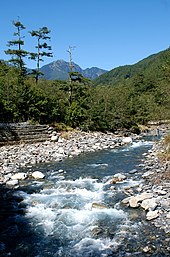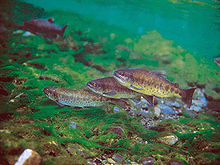Taiwanese masu salmon
| Taiwanese masu salmon | ||||||||||||
|---|---|---|---|---|---|---|---|---|---|---|---|---|

Taiwanese masu salmon ( Oncorhynchus masou formosanus ) |
||||||||||||
| Systematics | ||||||||||||
|
||||||||||||
| Scientific name | ||||||||||||
| Oncorhynchus masou formosanus | ||||||||||||
| ( DS Jordan & Ōshima , 1919) |
The Taiwanese masu salmon ( Oncorhynchus masou formosanus ) is a rare subspecies of the salmon species Masu salmon ( Oncorhynchus masou ) endemic to Taiwan . The name Masu comes from Japanese and means "trout".
features
The Taiwanese masu salmon can grow up to 30 centimeters long. The basic color is a dark turquoise, the belly color is silver. Along the sides of the body there are 9 vertical oval spots of dark color and 11 to 13 smaller black spots. During the mating season, the sides of the body of the males turn dark red. The mouth is wide and reaches under the eyes; its shape is reminiscent of a hook, which is where the scientific genus name Oncorhynchus and the Chinese name of the fish (literally: "hook-mouth salmon") come from.
distribution
The Taiwanese Masu salmon is a species endemic to Taiwan. It is a pure freshwater fish, very rare and only found in a few rivers in the Taiwanese high mountains, especially in the Qijiawan ( Taichung ) river. Like most salmon, the Taiwanese masu salmon also need a temperate climate (water temperature around 16 ° C) to survive. In predominantly subtropical Taiwan, it can therefore only be found at altitudes above around 1500 m, where there is a moderate climate.
The salmon that used to be numerous has now become very rare due to water pollution and the construction of dams that obstruct its hiking trails and is under nature protection. Further difficulties in the conservation of the Masu salmon arise from the rainbow trout ( Oncorhynchus mykiss ) imported from abroad , which exceeds the Masu salmon in size and robustness and has displaced it from parts of its habitat.
For about 30 years the salmon have been bred in rearing stations and successfully released in various mountain rivers. In 1997, the Qijiawan River area was declared a "Taiwan Masulmon Sanctuary". A slight increase in populations can currently be observed. Because of its uniqueness, salmon is known as a “national treasure” in Taiwan. As such, the animal also adorns Taiwan's 2,000 dollar bill .
Way of life
Before the Ice Age , Taiwanese salmon, like other salmon species, migrated back and forth between their spawning grounds on the upper reaches of the river and the sea. This way of life changed when the terrain and temperatures in Taiwan changed after the Ice Age. On the one hand, the now steep, rugged mountains hindered the salmon's hiking trails, on the other hand, the warming climate forced the salmon to avoid the plains and thus the estuaries into the sea. As a result of this development, the Taiwanese masu salmon became a pure freshwater fish that no longer migrates to the sea.
Masu salmon feed on aquatic insects. Often they die from exhaustion after the spawning season. Their life expectancy is 3 to 4 years.
Individual evidence
- ↑ http://life.nthu.edu.tw/~labtcs/Salmon/crisis/mykiss_salmon.htm The greatest enemy of the Taiwanese Masu salmon - the rainbow trout (chin.)

